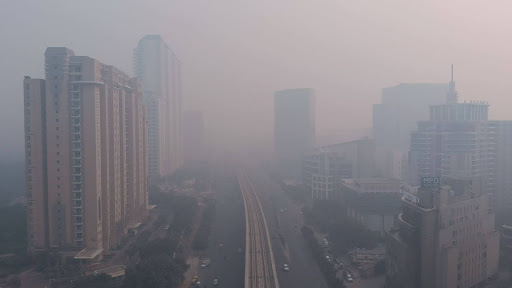Protecting our lungs and brains: Raising the profile of mental health at the WHO Second Conference on Air Pollution and Health
By Alessandro Massazza, Policy and Advocacy Advisor, Environment and Climate Change

A cloud of thick smog covers the city of Gurugram in India where air pollution reaches 50 times the level deemed safe by the World Health Organization. Credit: Raunaq Chopra / Climate Visuals Countdown
The air we breathe, day in and day out, impacts every organ of our body, from our lungs to our kidneys, from our hearts to our brains. Today, 99% of the world population breathes polluted air, this needs to change.
Air pollution is a huge global killer. It’s responsible for 8.1 million premature deaths every year, and is the second leading risk factor for death after high blood pressure. Air pollution now kills more people than tobacco. The majority of these deaths (90%) are due to noncommunicable diseases such as heart disease and lung cancer.
But there is a growing evidence-base emerging on the different ways in which air pollution can impact our brain health as well as our mental health. From harming developing brains to increasing the prevalence of strokes, air pollution has been shown to have a number of detrimental impacts on our brains. Additionally, air pollution is now recognized as one of the 14 modifiable risk factors for dementia.
Emerging evidence is also pointing to the negative impacts that air pollution can have on mental health, from increasing the risk of new mental health problems to worsening mental health in people living with pre-existing mental illness. In particular, a link has been established between exposure to air pollution and symptoms of depression as well as suicide rates. One study used drifting smoke from wildfires as the basis of a natural experimental in the United States to provide causal evidence that air pollution exposure increased suicide rates. In rural counties, a 1-μg/m3 (13%) increase in monthly wildfire-derived fine particulate matter lead to 0.27 additional suicide deaths per million residents (a 2.0% increase).
These impacts are costly for society. It has been estimated that the additional societal costs of mental disorders due to air pollution, changes in climate-related hazards and inadequate access to green space are estimated to be almost US$47 billion annually in 2030. This contributes to the massive US$8.1 trillion annual price tag for the overall health impacts of air pollution.
These deaths, illnesses, and additional costs are all preventable. Addressing air pollution is a win-win opportunity for both tackling climate change and improving population health. China’s clean air policies are a good case in point. Not only have they contributed to significant reductions in air pollution across the country but they have also been deemed responsible for the prevention of 46,000 suicides in the country over just 5 years.

Every Sunday in Bogotà, more than 100km of the city have no car traffic leaving spaces for pedestrians and cyclists. Credit: Enrique Penalosa
In the lead-up of the World Health Organization Second Conference on Air Pollution and Health taking places in Cartagena, Colombia in March 2025, we are joining millions of health and care workers, patients’ groups, and civil society organizations in calling on world leaders and decision makers to:
- enforce robust measures to stop polluting the air, cutting emissions at source, and swiftly achieve the full implementation of WHO global air quality guidelines;
- ensure a just and inclusive clean energy transition and fossil fuel phase out in a fair and equitable manner;
- strengthen actions for clean air, better monitoring and surveillance, and institutional capacity to limit air pollution and mitigate climate change;
- increase domestic and international funding to elevate clean air as a priority on global and national health and political agendas; and
- build intersectoral workforces with the skills and capacity to design and implement policies to tackle air pollution, focusing on continuous awareness raising, training, research, and sharing best public health practices, especially in the most affected countries.
As we approach the High-Level Meeting on NCDs and Mental Health, it’s fundamental that we continue highlighting the devastating impacts that air pollution has on non-communicable diseases such as cancers and stroke as well as on our mental health, while also spotlighting the immense public health co-benefits that can be unlocked through a transition to clean energy.
Clean air is not a luxury; it is a human right and vital for the physical and mental health of all, especially the most vulnerable.
The WHO Second Conference on Air Pollution and Health will take place between 25-29 in Cartagena, Colombia. You can read more about the conference here.

A woman in Mauritania cleans a solar panel as part of a solar energy project in her village. Credit: Raphael Pouget / Climate Visuals Countdown